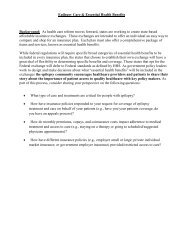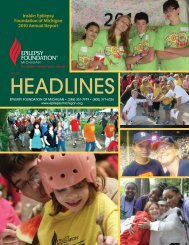Legal Rights of Children with Epilepsy in School & Child Care
Legal Rights of Children with Epilepsy in School & Child Care
Legal Rights of Children with Epilepsy in School & Child Care
You also want an ePaper? Increase the reach of your titles
YUMPU automatically turns print PDFs into web optimized ePapers that Google loves.
<strong>Legal</strong> <strong>Rights</strong> <strong>of</strong> <strong><strong>Child</strong>ren</strong> <strong>with</strong> <strong>Epilepsy</strong> <strong>in</strong> <strong>School</strong> and <strong>Child</strong> <strong>Care</strong><br />
already prepared <strong>with</strong> the appropriate dose, <strong>with</strong> a rectal tip that is either<br />
pediatric or universal <strong>in</strong> size. The most common side effects are drows<strong>in</strong>ess,<br />
headache, dizz<strong>in</strong>ess, diarrhea, flush<strong>in</strong>g, unsteady gait, agitation and confusion.<br />
A caregiver needs to call 911 after the medication is adm<strong>in</strong>istered only <strong>in</strong> the<br />
rare event that complications occur. Typically, the child’s treat<strong>in</strong>g physician will<br />
provide a treatment plan to the school or child care provider which spells out the<br />
monitor<strong>in</strong>g that may be required, as well as the particular circumstances under<br />
which it would be necessary to call 911, and <strong>in</strong>structions about when it is<br />
necessary to adm<strong>in</strong>ister the medication. Sample plans for child care programs<br />
and schools are provided <strong>in</strong> Appendices A and C.<br />
7.2Q: Are school districts required to provide staff to adm<strong>in</strong>ister emergency<br />
antiepileptic medication to students <strong>with</strong> epilepsy?<br />
A: Yes. If a student <strong>with</strong> epilepsy needs such medication <strong>in</strong> order to be able to<br />
attend school safely, he or she must have access to the medication, and the<br />
school district must identify at least one person who is able to adm<strong>in</strong>ister it. The<br />
United States Supreme Court’s decision <strong>in</strong> Cedar Rapids Community Sch. Dist.<br />
v. Garret F., 526 U.S. 66 (1999), makes clear that if a health service is needed <strong>in</strong><br />
order for a student to be able to attend school and participate <strong>in</strong> his or her<br />
educational program safely—and the service can be provided by a person other<br />
than a physician—then it is a “school health service” <strong>with</strong><strong>in</strong> the mean<strong>in</strong>g <strong>of</strong><br />
“related service” under the IDEA. 47 Adm<strong>in</strong>istration <strong>of</strong> emergency antiepileptic<br />
medication clearly fits <strong>with</strong><strong>in</strong> this def<strong>in</strong>ition.<br />
There are apparently no judicial decisions directly address<strong>in</strong>g adm<strong>in</strong>istration <strong>of</strong><br />
emergency antiepileptic medication, but there are at least two special education<br />
hear<strong>in</strong>g decisions on po<strong>in</strong>t: San Francisco Unified <strong>School</strong> District, California<br />
State Educational Agency, SN01-02331 (March 1, 2002), 37 IDELR 144<br />
(www3.scoe.net/speced/seho/seho_search/sehoSearchDetails.cfm?ID=1742) and<br />
Silsbee Independent <strong>School</strong> Dist., 25 IDELR 1023 (Tx. SEA 1997).<br />
In the San Francisco case, the school district had refused altogether to<br />
adm<strong>in</strong>ister diazepam and would call 911 as its only response to a prolonged<br />
seizure <strong>of</strong> five m<strong>in</strong>utes or more. The hear<strong>in</strong>g <strong>of</strong>ficer thoroughly analyzed<br />
available research on the safety <strong>of</strong> diazepam, considered the school district’s<br />
concerns about respiratory depression as a possible side effect and the school<br />
district’s reservations about adm<strong>in</strong>ister<strong>in</strong>g the medication, reviewed the parent’s<br />
history <strong>of</strong> emergency room visits <strong>with</strong> the student and the adverse effect these<br />
47 The Garret F. decision reiterated and expanded the Supreme Court’s earlier hold<strong>in</strong>g <strong>in</strong> Irv<strong>in</strong>g<br />
Independent Sch. Dist. v. Tatro, 468 U.S. 883 (1984). In Garret F., the Court made clear that even if a<br />
student requires one-to-one nurs<strong>in</strong>g services, as Garret did, that service is an IDEA-required related service<br />
because it can be provided by someone other than a physician.<br />
98








